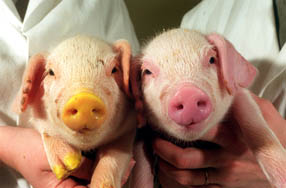|
|
|
...............Transgenic models........
Prior to the development of molecular genetics, the only way of studying the regulation and function of mammalian genes was through the observation of inherited characteristics or spontaneous mutations. Long before Mendel and any molecular genetic knowledge, selective breeding was a common practice among farmers for the enhancement of chosen traits, e.g., increased milk production.
The mutual contributions of developmental biology and genetic engineering permitted rapid development of the techniques for the creation of transgenic animals. DNA microinjection, the first technique to prove successful in mammals, was first applied to mice and then to various other species such as rats, rabbits, sheep, pigs, birds, and fish. Two other main techniques were then developed: those of retrovirus-mediated transgenesis and embryonic stem (ES) cell-mediated gene transfer .
Since 1981, when the term transgenic was first used by J.W. Gordon and F.H. Ruddle (1981), there has been rapid development in the use of genetically engineered animals as investigators have found an increasing number of applications for the technology.
Transgenic animals are a powerful tool for studying gene function and testing drugs. Many human genetic diseases can be modeled by introducing the same mutation into a mouse or other animal. Although similar genetic manipulations can be performed in tissue culture, the interaction of transgenes with proteins, hormones, neurotransmitters, and other components of an intact organism provides a much more complete and physiologically relevant picture of the transgene's function than could be achieved in any other way. With the development of transgenic livestock and plants, new uses for this technology have become apparent, some of potentially great economic and medical value. These include the ability to produce medically-useful recombinant proteins and antibodies on an industrial scale, as well as disease-resistant crops.
